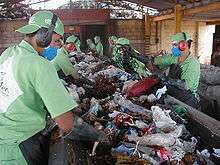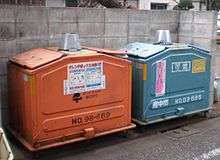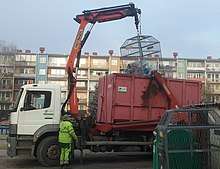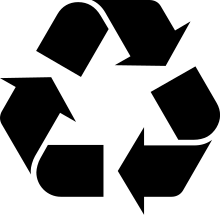Waste sorting
Waste sorting is the process by which waste is separated into different elements.[1] Waste sorting can occur manually at the household and collected through curbside collection schemes, or automatically separated in materials recovery facilities or mechanical biological treatment systems. Hand sorting was the first method used in the history of waste sorting.[2]




Waste can also be sorted in a civic amenity site.
"Waste segregation" means dividing waste into dry and wet. Dry waste includes wood and related products, metals and glass. Wet waste typically refers to organic waste usually generated by eating establishments and are heavy in weight due to dampness. Waste can also be segregeconomic concern. Waste Segregation is different from Waste Sorting. Waste Segregation means to group Waste into different Categories. Each waste goes into its category at the point of dumping or collection. Sorting comes after collection or dumping. According to the Cambridge Dictionary, sorting involves separating items into groups and cites sorting of wastes as an example.[3] Segregation of waste ensures pure, quality material. Sorting on the other hand will end up producing impure materials with less quality.
Methods
Waste is collected at its source in each area and separated. The way that waste is sorted must reflect local disposal systems. The following categories are common:[4]
- Paper
- Cardboard (including packaging for return to suppliers)
- Glass (clear, tinted – no light bulbs or window panes, which belong with residual waste)
- Plastics
- Textiles
- Wood, leather, rubber
- Scrap metal
- Compost
- Special/hazardous waste
- Residual waste
Organic waste can also be segregated for disposal:
- Leftover food which has had any contact with meat can be collected separately to prevent the spread of bacteria.
- Meat and bone can be retrieved by bodies responsible for animal waste.
- If other leftovers are sent, for example, to local farmers, they can be sterilised before being fed to the animals.
- Peels and scrapings from fruit and vegetables can be composted along with other degradable matter. Other waste can be included for composting, such as cut flowers, corks, coffee grounds, rotting fruit, tea bags, eggshells and nutshells, and paper towels.
Chip pan oil, used fats, vegetable oil and the content of fat filters can be collected by companies able to re-use them. Local authority waste departments can provide relevant addresses. This can be achieved by providing recycling bins.
By country
In Germany, regulations exist that provide mandatory quotas for the waste sorting of packaging waste and recyclable materials such as glass bottles.[5]
In Denpasar, Bali, Indonesia, a pilot project using an automated collecting machine of plastic bottles or aluminium cans with voucher reward has been implemented in a market.[6]
In India, waste segregation is said to be a mess due to its over population and accumulation of waste. But now India is in a developing state where government has launched its initiatives for the project of "Swachh Bharat Abhiyan". People are supporting this project and it is said that by 2025 we will be able to experience a healthy and clean India.
See also
References
- Garbage sorting plan | Shanghai Daily
- Aluminum Recycling, Second Edition - Mark E. Schlesinger. pp. 75-76.
- Martin F. Lemann: Waste Management, 2008, p. 80, ISBN 9783039115143, Peter Lang
- Germany, Garbage and the Green Dot: Challenging a Throwaway Society - Bette K. Fishbein. pp. 16-17.
- "Satu-satunya di Indonesia, Mesin Sampah Keluarkan Voucher ada di Denpasar". July 31, 2015.
External links


